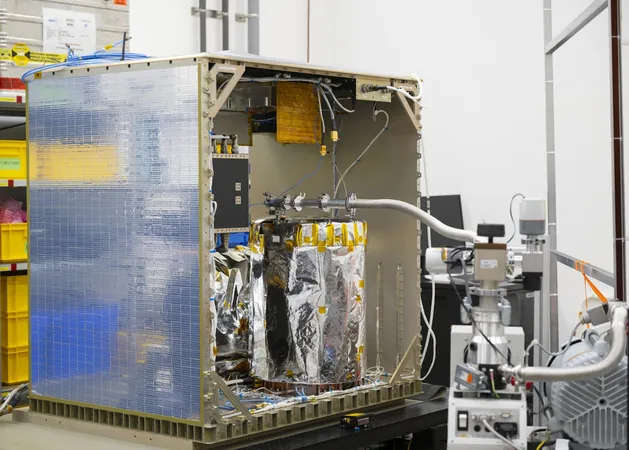
Unlocking the Mysteries of Time: The Atomic Clock Ensemble in Space (ACES)
2024-11-11
Author: Wei Ling
The Atomic Clock Ensemble in Space (ACES) - Introduction
The Atomic Clock Ensemble in Space (ACES) represents a groundbreaking initiative by the European Space Agency (ESA) to enhance our comprehension of fundamental physics right from the International Space Station (ISS). This state-of-the-art facility will be positioned on the Columbus module of the ISS, where it will harness an exceptional 'network of clocks' to synchronize and compare its highly accurate timepieces with some of the best atomic clocks back on Earth. The ultimate goal? A profound exploration of how gravity influences the very fabric of time.
Time and Gravity: Einstein's Radical Theory
Einstein's general relativity posits that the flow of time can be affected by gravitational forces. Ingenious experiments conducted on Earth have demonstrated that time can pass differently at varying altitudes — for instance, time elapses quicker at the peaks of mountains than at sea level. ACES will elevate this research to new heights — literally — carrying out precise measurements in the unique environment of the ISS, which orbits around 400 kilometers above our planet.
Meet the Cutting-Edge Clocks
ACES is outfitted with two innovative clocks: PHARAO, which stands for 'Projet d’Horloge Atomique à Refroidissement d’Atomes en Orbite,' and SHM, or 'Space Hydrogen Maser.'
**PHARAO** is a remarkable caesium atomic clock developed by the French space agency CNES. It employs laser technology to chill caesium atoms to temperatures nearing absolute zero, allowing it to attain unprecedented precision in measuring time and frequency. Unlike traditional caesium fountain clocks found on Earth, which require substantial size to operate due to gravitational effects, PHARAO’s design capitalizes on microgravity conditions aboard the ISS, resulting in a much more compact and stable unit.
**SHM** serves as an active hydrogen maser, engineered by Safran Time Technologies in Switzerland. This clock utilizes hydrogen atoms as a frequency reference, achieving stability that is ten times greater than that of similar passive masers employed in a various satellite systems, such as Galileo.
Together, these two clocks boast an astonishing precision of one second over an impressive 300 million years, solidifying ACES' place at the forefront of timekeeping technology.
Data Collection in Space
Upon its deployment, ACES will be strategically mounted onto the Columbus module via a robotic arm and will remain operational for 30 months, during which extensive data collection will take place. Researchers in Europe, operating from CADMOS in Toulouse and the Columbus Control Centre near Munich, will oversee the project. ACES aims to gather continuous data across ten sessions of 25 days each, employing both microwave and optical links to transmit clock signals back to a global network of ground-based atomic clocks.
Pushing the Frontier of Scientific Inquiry
The potential scientific advancements heralded by ACES are staggering. By comparing the behavior of clocks in space and on Earth, ACES will provide invaluable data for investigating Einstein’s gravitational time dilation, probing the stability of fundamental constants, and even searching for dark matter.
Moreover, this sophisticated clock network will empower researchers to quantify geopotential differences across various continents, execute clock synchronizations, and enhance global timekeeping methodologies. With optical clocks achieving fractional frequency stability that outpaces traditional microwave clocks, ACES aims to revolutionize how we measure time with an accuracy previously deemed impossible.
Luigi Cacciapuoti, the ACES project scientist at ESA, expresses immense excitement regarding the project’s contributions, stating, 'This is an urgent need in the scientific community and will surely play a key role in redefining the standard unit of time.'
A Journey Three Decades in the Making
The path to ACES has spanned over 30 years, highlighting the sophisticated technology and intricate engineering involved in this monumental project. From its scaled-down designs that resemble modern refrigerators to the elaborate precautions taken to guard against magnetic interferences, the development of ACES serves as a testament to human ingenuity and determination.
As it stands, the ACES project is fully assembled at Airbus facilities in Friedrichshafen, Germany, undergoing thorough testing with an impending launch aboard a SpaceX Falcon 9 rocket scheduled for the first half of 2025.
What’s Next?
With ACES set to transform our understanding of time and gravity, the scientific community is on the brink of revelations that could redefine the essence of our universe. Buckle up, time travelers — the future of physics is about to be rewritten!





 Brasil (PT)
Brasil (PT)
 Canada (EN)
Canada (EN)
 Chile (ES)
Chile (ES)
 España (ES)
España (ES)
 France (FR)
France (FR)
 Hong Kong (EN)
Hong Kong (EN)
 Italia (IT)
Italia (IT)
 日本 (JA)
日本 (JA)
 Magyarország (HU)
Magyarország (HU)
 Norge (NO)
Norge (NO)
 Polska (PL)
Polska (PL)
 Schweiz (DE)
Schweiz (DE)
 Singapore (EN)
Singapore (EN)
 Sverige (SV)
Sverige (SV)
 Suomi (FI)
Suomi (FI)
 Türkiye (TR)
Türkiye (TR)